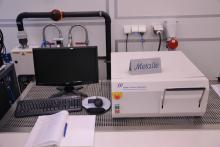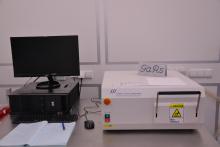Annealing processes are carried out to convert grown layers into a thermodynamically stable state or to trigger reactions in the sample.
Annealing processes are mostly used to convert grown layers into a thermodynamically stable state. In this way, lattice defects (atoms on interstitial places and vacancies) can be healed or atomic point defects can be saturated in reactions with hydrogen/forming gas and thus deactivated. Reactions can also be triggered in the sample (e.g. crystallisation, dopant activation). Different furnaces are used depending on the specific task.

Forming gas oven
This is where the thermal treatment takes place in a horizontal tube furnace.
PLC-controlled horizontal furnace from ATV Technologie with cylindrical quartz glass process chamber for max. 200 mm wafers with freely adjustable hydrogen-nitrogen ratio.
Typically, annealing processes are carried out in this furnace over several hours.
RTP ovens
While annealing processes are usually carried out over several hours, this can be achieved in a shorter time for single wafers with Rapid Tthermal Processing furnaces.
Several Rapid Thermal Processing (RTP) ovens are available for fast and short thermal processing. Using high-intensity infrared lamps, substrates can be processed at very high heating rates and under different atmospheres/vacuum and cooled down again just as quickly. These annealing processes trigger reactions in the sample (e.g. crystallisation, dopant activation). Ultra-thin layers can also be grown on the surface in a controlled manner by reacting with the process gas (e.g. oxides or nitrides).

RTP 1
This furnace is used for the processing of metallic and oxide layers in various process chambers.
Surfe Science Integration (SSI) Solaris 150
- Temperature: up to 1200 °C
- Heating rates: up to 150 K/s resp. 20 K/s (susceptor)
- Cooling rate: < 150 K/s (process and temperature-dependent)
- Wafer diameter: up to 150 mm (6") or 100 mm (in 4" susceptor) or PV cell
- Process gases: N2, Ar, O2

RTP 2
We use this furnace exclusively for the thermal processing of GaAs substrates.
Surfe Science Integration (SSI) Solaris 150 - GaAs
- Temperature: up to 400 °C
- Heating rates: up to 10 K/s (susceptor)
- Wafer diameter: up to 100 mm (4") in the 4" susceptor
- Process gas: N2

Reactive gas RTP
This furnace is available for annealing processes under high vacuum or reactive gases.
Annealsys AS-One 150
- Temperatures up to 1200°C, heating ramps up to 150 K/s
- Wafer diameters up to 150 mm (primarily silicon)
- Gases: N2, Ar, O2, H2, NH3 with pressure control
- Temperature measurement via thermocouple or pyrometer
- Turbomolecular pump for high vacuum
- Fast cooling system
Applications: RTA (Rapid Thermal Annealing), RTO (Rapid Thermal Oxidation), RTN (Rapid Thermal Nitridation), H2 passivation